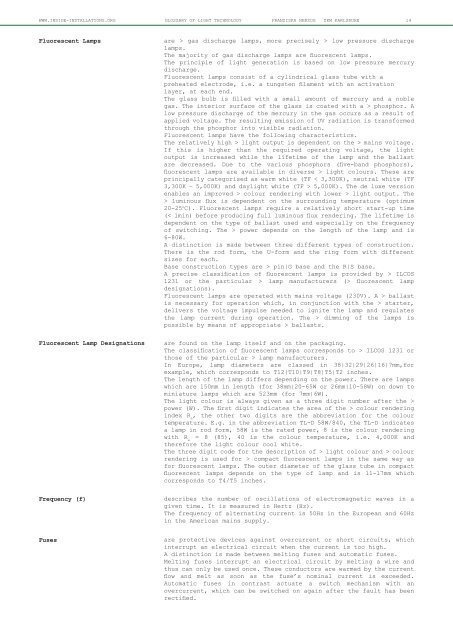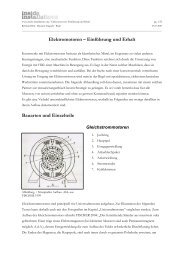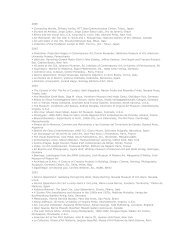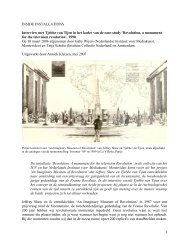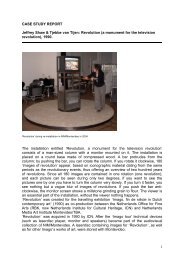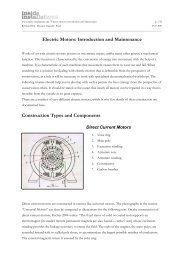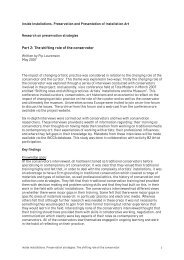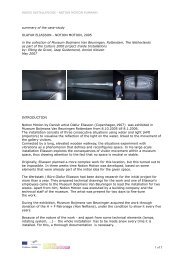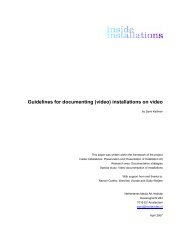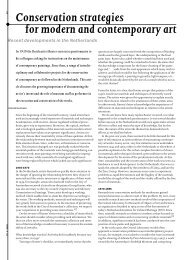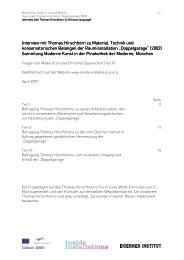GLOSSARY OF LIGHT TECHNOLOGY - Inside Installations
GLOSSARY OF LIGHT TECHNOLOGY - Inside Installations
GLOSSARY OF LIGHT TECHNOLOGY - Inside Installations
Create successful ePaper yourself
Turn your PDF publications into a flip-book with our unique Google optimized e-Paper software.
WWW.INSIDE-INSTALLATIONS.ORG <strong>GLOSSARY</strong> <strong>OF</strong> <strong>LIGHT</strong> <strong>TECHNOLOGY</strong> FRANZISKA HERZOG ZKM KARLSRUHE 14<br />
Fluorescent Lamps<br />
Fluorescent Lamp Designations<br />
Frequency (f)<br />
Fuses<br />
are > gas discharge lamps, more precisely > low pressure discharge<br />
lamps.<br />
The majority of gas discharge lamps are fluorescent lamps.<br />
The principle of light generation is based on low pressure mercury<br />
discharge.<br />
Fluorescent lamps consist of a cylindrical glass tube with a<br />
preheated electrode, i.e. a tungsten filament with an activation<br />
layer, at each end.<br />
The glass bulb is filled with a small amount of mercury and a noble<br />
gas. The interior surface of the glass is coated with a > phosphor. A<br />
low pressure discharge of the mercury in the gas occurs as a result of<br />
applied voltage. The resulting emission of UV radiation is transformed<br />
through the phosphor into visible radiation.<br />
Fluorescent lamps have the following characteristics.<br />
The relatively high > light output is dependent on the > mains voltage.<br />
If this is higher than the required operating voltage, the light<br />
output is increased while the lifetime of the lamp and the ballast<br />
are decreased. Due to the various phosphors (five-band phosphors),<br />
fluorescent lamps are available in diverse > light colours. These are<br />
principally categorised as warm white (TF < 3,300K), neutral white (TF<br />
3,300K – 5,000K) and daylight white (TF > 5,000K). The de luxe version<br />
enables an improved > colour rendering with lower > light output. The<br />
> luminous flux is dependent on the surrounding temperature (optimum<br />
20-25 o C). Fluorescent lamps require a relatively short start-up time<br />
(< 1min) before producing full luminous flux rendering. The lifetime is<br />
dependent on the type of ballast used and especially on the frequency<br />
of switching. The > power depends on the length of the lamp and is<br />
6-80W.<br />
A distinction is made between three different types of construction.<br />
There is the rod form, the U-form and the ring form with different<br />
sizes for each.<br />
Base construction types are > pin|G base and the R|S base.<br />
A precise classification of fluorescent lamps is provided by > ILCOS<br />
1231 or the particular > lamp manufacturers (> fluorescent lamp<br />
designations).<br />
Fluorescent lamps are operated with mains voltage (230V). A > ballast<br />
is necessary for operation which, in conjunction with the > starter,<br />
delivers the voltage impulse needed to ignite the lamp and regulates<br />
the lamp current during operation. The > dimming of the lamps is<br />
possible by means of appropriate > ballasts.<br />
are found on the lamp itself and on the packaging.<br />
The classification of fluorescent lamps corresponds to > ILCOS 1231 or<br />
those of the particular > lamp manufacturers.<br />
In Europe, lamp diameters are classed in 38|32|29|26|16|7mm,for<br />
example, which corresponds to T12|T10|T9|T8|T5|T2 inches.<br />
The length of the lamp differs depending on the power. There are lamps<br />
which are 150mm in length (for 38mm|20-65W or 26mm|10-58W) on down to<br />
miniature lamps which are 523mm (for 7mm|6W).<br />
The light colour is always given as a three digit number after the ><br />
power (W). The first digit indicates the area of the > colour rendering<br />
index R a , the other two digits are the abbreviation for the colour<br />
temperature. E.g. in the abbreviation TL-D 58W/840, the TL-D indicates<br />
a lamp in rod form, 58W is the rated power, 8 is the colour rendering<br />
with R a = 8 (85), 40 is the colour temperature, i.e. 4,000K and<br />
therefore the light colour cool white.<br />
The three digit code for the description of > light colour and > colour<br />
rendering is used for > compact fluorescent lamps in the same way as<br />
for fluorescent lamps. The outer diameter of the glass tube in compact<br />
fluorescent lamps depends on the type of lamp and is 11-17mm which<br />
corresponds to T4/T5 inches.<br />
describes the number of oscillations of electromagnetic waves in a<br />
given time. It is measured in Hertz (Hz).<br />
The frequency of alternating current is 50Hz in the European and 60Hz<br />
in the American mains supply.<br />
are protective devices against overcurrent or short circuits, which<br />
interrupt an electrical circuit when the current is too high.<br />
A distinction is made between melting fuses and automatic fuses.<br />
Melting fuses interrupt an electrical circuit by melting a wire and<br />
thus can only be used once. These conductors are warmed by the current<br />
flow and melt as soon as the fuse’s nominal current is exceeded.<br />
Automatic fuses in contrast actuate a switch mechanism with an<br />
overcurrent, which can be switched on again after the fault has been<br />
rectified.


